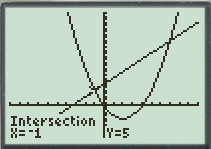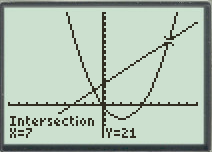
To calculate: The solution of the equation
Answer to Problem 95RE
The solution of the equation
Explanation of Solution
Given information:
The equation is
Calculation:
Consider the equation
Divide the above equation in two parts.
Follow the steps provided below to estimate the solution of the equation,
Step 1: Press
Step 2: Enter the function
Step 3: Press the
Step 4: Press
Step 5: Choose the 5th option that is the intersect feature.
Step 6: Press
Step 7: Guess the intersect point and press
The result obtained on screen is provided below,

The graphs intersect at
Step 8: Press
Step 9: Choose the 5th option that is the intersect feature.
Step 10: Press
Step 11: Guess the intersect point and press
The result obtained on screen is provided below,

The graphs intersect at
There are two points of intersection that depict the solution of the equation.
Thus, the solution of the equation
Chapter 1 Solutions
Precalculus: Mathematics for Calculus - 6th Edition
 Calculus: Early TranscendentalsCalculusISBN:9781285741550Author:James StewartPublisher:Cengage Learning
Calculus: Early TranscendentalsCalculusISBN:9781285741550Author:James StewartPublisher:Cengage Learning Thomas' Calculus (14th Edition)CalculusISBN:9780134438986Author:Joel R. Hass, Christopher E. Heil, Maurice D. WeirPublisher:PEARSON
Thomas' Calculus (14th Edition)CalculusISBN:9780134438986Author:Joel R. Hass, Christopher E. Heil, Maurice D. WeirPublisher:PEARSON Calculus: Early Transcendentals (3rd Edition)CalculusISBN:9780134763644Author:William L. Briggs, Lyle Cochran, Bernard Gillett, Eric SchulzPublisher:PEARSON
Calculus: Early Transcendentals (3rd Edition)CalculusISBN:9780134763644Author:William L. Briggs, Lyle Cochran, Bernard Gillett, Eric SchulzPublisher:PEARSON Calculus: Early TranscendentalsCalculusISBN:9781319050740Author:Jon Rogawski, Colin Adams, Robert FranzosaPublisher:W. H. Freeman
Calculus: Early TranscendentalsCalculusISBN:9781319050740Author:Jon Rogawski, Colin Adams, Robert FranzosaPublisher:W. H. Freeman
 Calculus: Early Transcendental FunctionsCalculusISBN:9781337552516Author:Ron Larson, Bruce H. EdwardsPublisher:Cengage Learning
Calculus: Early Transcendental FunctionsCalculusISBN:9781337552516Author:Ron Larson, Bruce H. EdwardsPublisher:Cengage Learning





